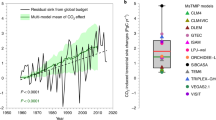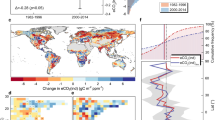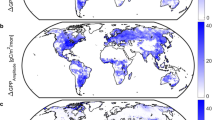Abstract
Elevated CO2 concentrations increase photosynthesis and, potentially, net ecosystem production (NEP), meaning a greater CO2 uptake. Climate, nutrients and ecosystem structure, however, influence the effect of increasing CO2. Here we analysed global NEP from MACC-II and Jena CarboScope atmospheric inversions and ten dynamic global vegetation models (TRENDY), using statistical models to attribute the trends in NEP to its potential drivers: CO2, climatic variables and land-use change. We found that an increased CO2 was consistently associated with an increased NEP (1995–2014). Conversely, increased temperatures were negatively associated with NEP. Using the two atmospheric inversions and TRENDY, the estimated global sensitivities for CO2 were 6.0 ± 0.1, 8.1 ± 0.3 and 3.1 ± 0.1 PgC per 100 ppm (~1 °C increase), and −0.5 ± 0.2, −0.9 ± 0.4 and −1.1 ± 0.1 PgC °C−1 for temperature. These results indicate a positive CO2 effect on terrestrial C sinks that is constrained by climate warming.
This is a preview of subscription content, access via your institution
Access options
Access Nature and 54 other Nature Portfolio journals
Get Nature+, our best-value online-access subscription
$29.99 / 30 days
cancel any time
Subscribe to this journal
Receive 12 print issues and online access
$209.00 per year
only $17.42 per issue
Buy this article
- Purchase on Springer Link
- Instant access to full article PDF
Prices may be subject to local taxes which are calculated during checkout


Similar content being viewed by others
Data availability
The authors declare that the data supporting the findings of this study are publicly available in the web pages provided in the article. The TRENDY simulations are available from the corresponding author upon request.
References
Canadell, J. G. et al. Contributions to accelerating atmospheric CO2 growth from economic activity, carbon intensity, and efficiency of natural sinks. Proc. Natl Acad. Sci. USA 104, 18866–18870 (2007).
Le Quéré, C. et al. Global carbon budget 2017. Earth Syst. Sci. Data 10, 405–448 (2018).
Ciais, P. et al. Europe-wide reduction in primary productivity caused by the heat and drought in 2003. Nature 437, 529–533 (2005).
Crowther, T. W. et al. Quantifying global soil carbon losses in response to warming. Nature 540, 104–108 (2016).
Fernández-Martínez, M. et al. Atmospheric deposition, CO2, and change in the land carbon sink. Sci. Rep. 7, 1–13 (2017).
Peñuelas, J. et al. Shifting from a fertilization-dominated to a warming dominated period. Nat. Ecol. Evol. 1, 1438–1445 (2017).
Ainsworth, E. A. & Long, S. P. What have we learned from 15 years of free-air CO2 enrichment (FACE)? A meta-analytic review of the responses of photosynthesis, canopy properties and plant production to rising CO2. New Phytol. 165, 351–371 (2005).
Medlyn, B. E. et al. Using ecosystem experiments to improve vegetation models. Nat. Clim. Change 5, 528–534 (2015).
Keenan, T. F. et al. Increase in forest water-use efficiency as atmospheric carbon dioxide concentrations rise. Nature 499, 324–327 (2013).
IPCC: Summary for Policymakers. In Climate Change 2013: The Physical Science Basis (eds Stocker, T. F. et al.) (Cambridge Univ. Press, 2013).
Fernández-Martínez, M. et al. Spatial variability and controls over biomass stocks, carbon fluxes and resource-use efficiencies in forest ecosystems. Trees Struct. Funct. 28, 597–611 (2014).
Beer, C. et al. Terrestrial gross carbon dioxide uptake: global distribution and covariation with climate. Science 329, 834–838 (2010).
Luyssaert, S. et al. CO2 balance of boreal, temperate, and tropical forests derived from a global database. Glob. Change Biol. 13, 2509–2537 (2007).
de Vries, W. & Posch, M. Modelling the impact of nitrogen deposition, climate change and nutrient limitations on tree carbon sequestration in Europe for the period 1900–2050. Environ. Pollut. 159, 2289–2299 (2011).
Wamelink, G. W. W. et al. Modelling impacts of changes in carbon dioxide concentration, climate and nitrogen deposition on carbon sequestration by European forests and forest soils. For. Ecol. Manage. 258, 1794–1805 (2009).
Wamelink, G. W. W. et al. Effect of nitrogen deposition reduction on biodiversity and carbon sequestration. For. Ecol. Manage. 258, 1774–1779 (2009).
de Vries, W., Du, E. & Butterbach-Bahl, K. Short and long-term impacts of nitrogen deposition on carbon sequestration by forest ecosystems. Curr. Opin. Environ. Sustain. 9–10, 90–104 (2014).
Luyssaert, S. et al. The European carbon balance. Part 3: forests. Glob. Change Biol. 16, 1429–1450 (2010).
Magnani, F. et al. The human footprint in the carbon cycle of temperate and boreal forests. Nature 447, 848–850 (2007).
Thomas, R. B., Spal, S. E., Smith, K. R. & Nippert, J. B. Evidence of recovery of Juniperus virginiana trees from sulfur pollution after the Clean Air Act. Proc. Natl Acad. Sci. USA 110, 15319–15324 (2013).
Oulehle, F. et al. Major changes in forest carbon and nitrogen cycling caused by declining sulphur deposition. Glob. Change Biol. 17, 3115–3129 (2011).
Truog, E. Soil reaction influence on availability of plant nutrients. Soil Sci. Soc. Am. J. 11, 305–308 (1946).
Fernández-Martínez, M. et al. Nutrient availability as the key regulator of global forest carbon balance. Nat. Clim. Change 4, 471–476 (2014).
Zhu, Z. et al. Greening of the Earth and its drivers. Nat. Clim. Change 6, 791–795 (2016).
Chevallier, F. et al. CO2 surface fluxes at grid point scale estimated from a global 21 year reanalysis of atmospheric measurements. J. Geophys. Res. 115, D21307 (2010).
Rödenbeck, C., Houweling, S., Gloor, M. & Heimann, M. CO2 flux history 1982–2001 inferred from atmospheric data using a global inversion of atmospheric transport. Atmos. Chem. Phys. 3, 1919–1964 (2003).
Aber, J. et al. Forest processes and global environmental change: predicting the effects of individual and multiple stressors. Bioscience 51, 735–751 (2001).
Prentice, I. C., Heimann, M. & Sitch, S. The carbon balance of the terrestrial biosphere: ecosystem models and atmospheric observations. Ecol. Appl. 10, 1553–1573 (2000).
Cheng, L. et al. Recent increases in terrestrial carbon uptake at little cost to the water cycle. Nat. Commun. 8, 110 (2017).
Norby, R. J., Warren, J. M., Iversen, C. M., Medlyn, B. E. & McMurtrie, R. E. CO2 enhancement of forest productivity constrained by limited nitrogen availability. Proc. Natl Acad. Sci. USA 107, 19368–19373 (2010).
Norby, R. J. et al. Forest response to elevated CO2 is conserved across a broad range of productivity. Proc. Natl Acad. Sci. USA 102, 18052–18056 (2005).
Van Groenigen, K. J. et al. The impact of elevated atmospheric CO2 on soil C and N dynamics. Ecol. Stud. 187, 374–391 (2006).
Terrer, C. et al. Mycorrhizal association as a primary control of the CO2 fertilization effect. Science 353, 72–74 (2016).
McCarthy, H. R. et al. Re-assessment of plant carbon dynamics at the Duke free-air CO2 enrichment site: interactions of atmospheric [CO2] with nitrogen and water availability over stand development. New Phytol. 185, 514–528 (2010).
Hyvönen, R. et al. The likely impact of elevated [CO2], nitrogen deposition, increased temperature and management on carbon sequestration in temperate and boreal forest ecosystems: a literature review. New Phytol. 173, 463–480 (2007).
Ryan, M. G. Effects of climate change on plant respiration. Ecol. Appl. 1, 157–167 (1991).
Amthor, J. S. Scaling CO2–photosynthesis relationships from the leaf to the canopy. Photosynth. Res. 39, 321–350 (1994).
Wu, Z., Dijkstra, P., Koch, G. W., Peñuelas, J. & Hungate, B. A. Responses of terrestrial ecosystems to temperature and precipitation change: a meta-analysis of experimental manipulation. Glob. Change Biol. 17, 927–942 (2011).
Chevallier, F. et al. Toward robust and consistent regional CO2 flux estimates from in situ and spaceborne measurements of atmospheric CO2. Geophys. Res. Lett. 41, 1065–1070 (2014).
Olivier, J. G. J. & Berdowski, J. J. M. in The Climate System (eds Berdowski, J., Guicherit, R. & Heij, B. J.) 33–78 (Swets and Zeitlinger, Leiden, 2001).
Sitch, S. et al. Recent trends and drivers of regional sources and sinks of carbon dioxide. Biogeosciences 12, 653–679 (2015).
Harris, I., Jones, P. D. D., Osborn, T. J. J. & Lister, D. Updated high-resolution grids of monthly climatic observations—the CRU TS3.10 Dataset. Int. J. Climatol. 34, 623–642 (2013).
Vicente-serrano, S. M., Beguería, S. & López-Moreno, J. I. A multiscalar drought index sensitive to global warming: the Standardized Precipitation Evapotranspiration Index. J. Clim. 23, 1696–1718 (2010).
Zuur, A., Ieno, E., Walker, N., Saveliev, A. & Smith, G. Mixed Effects Models and Extensions in Ecology with R (Springer, New York, 2009).
Mathias, J. M. & Thomas, R. B. Disentangling the effects of acidic air pollution, atmospheric CO2, and climate change on recent growth of red spruce trees in the Central Appalachian Mountains. Glob. Change Biol. 24, 3938–3953 (2018).
R Core Team R: A Language and Environment for Statistical Computing (Scientific Research, Wuhan, 2016).
Barton, K. MuMIn: Multi-model inference. R package version 1.17.1 (R Foundation for Statistical Computing, 2015); http://CRAN.R-project.org/package=MuMIn
Nakagawa, S. & Schielzeth, H. A general and simple method for obtaining R 2 from generalized linear mixed-effects models. Methods Ecol. Evol. 4, 133–142 (2013).
Breheny, P. & Burchett, W. Visualization of regression models using visreg. R package version 2, 2–0 (R Foundation for Statistical Computing, 2015).
Acknowledgements
This research was supported by the Spanish Government project CGL2016–79835-P (FERTWARM), the European Research Council Synergy grant no. ERC-2013-726 SyG-610028 IMBALANCE-P and the Catalan Government project SGR 2017–1005. M.F.-M. and S.V. are postdoctoral fellows of the Research Foundation—Flanders. J.G.C. thanks the support of the National Environmental Science Programme ESCC Hub. We thank C. Röedenbeck for his advice and for distributing Jena CarboScope and all the modellers that contributed to the TRENDY project.
Author information
Authors and Affiliations
Contributions
M.F.-M., J.S., I.A.J. and J.P. conceived, analysed and wrote the paper. F.C., P.F. and S.S. provided the data. All the authors contributed substantially to the writing and discussion of the paper.
Corresponding author
Ethics declarations
Competing interests
The authors declare no competing interests.
Additional information
Publisher’s note: Springer Nature remains neutral with regard to jurisdictional claims in published maps and institutional affiliations.
Supplementary information
Supplementary Information
Supplementary discussion, Supplementary Figure 1, Supplementary Tables 1–24, Supplementary references
Rights and permissions
About this article
Cite this article
Fernández-Martínez, M., Sardans, J., Chevallier, F. et al. Global trends in carbon sinks and their relationships with CO2 and temperature. Nature Clim Change 9, 73–79 (2019). https://doi.org/10.1038/s41558-018-0367-7
Received:
Accepted:
Published:
Issue Date:
DOI: https://doi.org/10.1038/s41558-018-0367-7
This article is cited by
-
Elevated CO2 levels promote both carbon and nitrogen cycling in global forests
Nature Climate Change (2024)
-
Evaluate the differences in carbon sink contribution of different ecological engineering projects
Carbon Research (2024)
-
The fusion of multiple scale data indicates that the carbon sink function of the Qinghai-Tibet Plateau is substantial
Carbon Balance and Management (2023)
-
A joint framework for studying compound ecoclimatic events
Nature Reviews Earth & Environment (2023)
-
Diagnosing destabilization risk in global land carbon sinks
Nature (2023)



